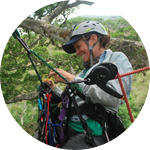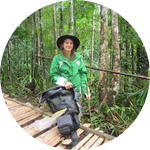About This Project
Epiphytes grow in the canopy of trees, deriving support from their hosts, but getting water and nutrients from rain and mist. They enhance nutrient and water cycles and provide resources to arboreal animals in forests, but their functions in human-altered habitats remain unknown. As conversion of forest to agricultural land in the tropics is increasing, I wish to examine the effects that pastures have on epiphyte population variability in the tropical landscapes of Costa Rica.
Ask the Scientists
Join The DiscussionWhat is the context of this research?
Trees in pastures may act as “keystone” structures, providing connectivity and refuge for plants and animals (Werner et al. 2005). However, pastures support fewer trees separated by greater distances, than in forest habitats. Epiphytes on pasture trees may be vulnerable to lower gene flow and inbreeding because of their isolation (Trapnell & Hamrick 2005). I am focusing on the epiphyte Catopsis nitida in Bromeliaceae (pineapple family) because they are common in both forest and pasture habitats, which is uncommon for many other epiphyte families. Our initial findings show that populations of Catopsis nitida are closely related within pastures. However, between pastures, epiphyte populations are not closely related, suggesting that mating among epiphytes may be restricted within pastures.
What is the significance of this project?
Epiphytes make up about 1/3 of the plant diversity in the tropical forests of Latin America (Gentry & Dodson 1987). Understanding the role of land conversion on epiphyte populations can tell us a great deal about conservation practices and land management for these important tropical plant populations. Because of the previously difficult nature of obtaining epiphyte samples in forest trees (many found high in the canopy of trees), few studies have focused on population genetics of epiphytes. Furthermore, the long standing culture of both dairy farming and land preservation makes the community of Monteverde, Costa Rica an appropriate location for this study because there is a mixture of active pasture farms and preserved forest land (Nadkarni & Wheelwright 2000).
What are the goals of the project?
My near-term goal is to understand the effects that isolated systems (e.g., pasture areas) have on epiphyte populations in the montane tropical landscapes of Costa Rica. The funds will be used to: a) identify the genotypes using microsatellite markers of the epiphyte Catopsis nitida for individuals from pasture trees and from forest trees, b) germinate seeds of Catopsis nitida to compare genotypes of offspring to parental plants, and c) develop microsatellite markers for an additional Bromeliaceae species. My longer-term goal is to relate my findings to other tropical areas and other species in ways that will inform conservationists and land-managers about the vulnerability and resilience of canopy-dwelling plants in tropical landscapes to enable scientifically-sound land use decisions.
Budget
These funds will support the analyses of Catopsis nitida samples and other epiphyte species that I collect during my field work in the Summer of 2016 (for which I already have funds).
- I have already obtained microsatellite primers for Catopsis nitida, but require funds for the development of microsatellite primers for an additional epiphyte species (in companion genera of the Bromeliaceae).
- I also request funds for the analysis of additional Catopsis nitida samples from pastures and forest habitat (Summer 2016).
- Last, I request funds for greenhouse space to carry out experiments on seed germination of my target species. This includes funds for materials, water use, and renting space in the Department of Biology’s greenhouse at the University of Utah.
Endorsed by
Meet the Team
Autumn Amici
The root of my passion for nature began at a young age. Some of my earliest memories include bird watching with my mom and dissecting the mosses and lichens on the rocks outside my childhood home. As captain
of the Envirothon competition team and president of science club in high school, I continued to cultivate a desire to work in the field of conservation. I completed Bachelor of Science degrees in Wildlife Biology and Natural Resources at the University of Vermont (2011). Following my undergraduate degree, I completed an M.S. degree in Botany in Dr. Tom A. Ranker’s lab at the University of Hawaii at Manoa’s (2013). Through exploring and learning more about the morphology and adaptations of plants, I continued to develop a strong desire to work in tree canopies, where many epiphytes reside. This has led me to my current research pursuits in Dr. Nalini M. Nadkarni's lab at the University of Utah's Department of Biology.
Additional Information
I plan to post photos and videos of my data collection while in Monteverde, Costa Rica during the summer of 2016. Please visit the blog on my website (http://autumnamici.weebly.com/), if you are interested in seeing the progress of this project.
Bibliography
GENTRY, A. H. & C. H. DODSON. 1987. Diversity and Biogeography of Neotropical Vascular Epiphytes. Annals of the Missouri Botanical Garden 74:205–233.
NADKARNI, N. M., M. C. MERWIN & J. NIEDER. 2001. Forest canopies: plant diversity. Pp. 27–40 in Levin, S. (ed.). Encyclopedia of Biodiversity. Academic Press, San Diego.
NADKARNI, N. M. & N. T. WHEELWRIGHT. (Eds.). 2000. Monteverde: Ecology and Conservation of a Tropical Cloud Forest. Oxford University Press.
TRAPNELL, D. W. & J. L. HAMRICK. 2005. Mating patterns and gene flow in the neotropical epiphytic orchid, Laelia rubescens. Molecular Ecology 14:75–84.
WERNER, F. F. A, J. HOMEIER, S. R. GRADSTEIN, S. BOTANIK & A. PFLANZENWISSENSCHAFTEN. 2005. Diversity of vascular epiphytes on isolated remnant trees in the montane forest belt of southern Ecuador. Ecotropica 11:21–40.
Project Backers
- 35Backers
- 103%Funded
- $3,408Total Donations
- $97.37Average Donation



